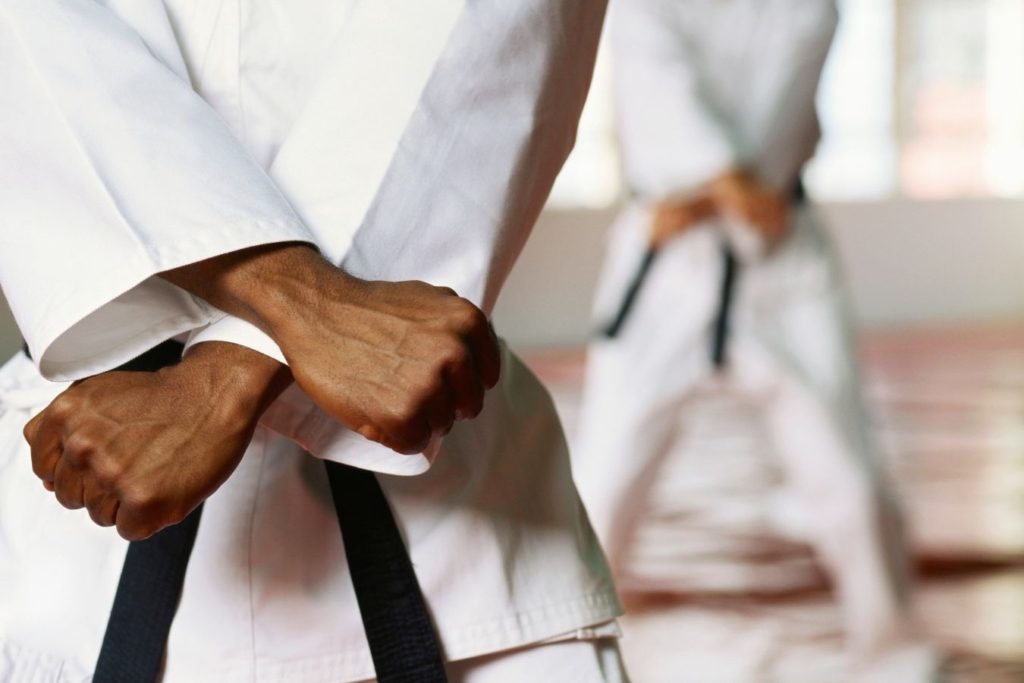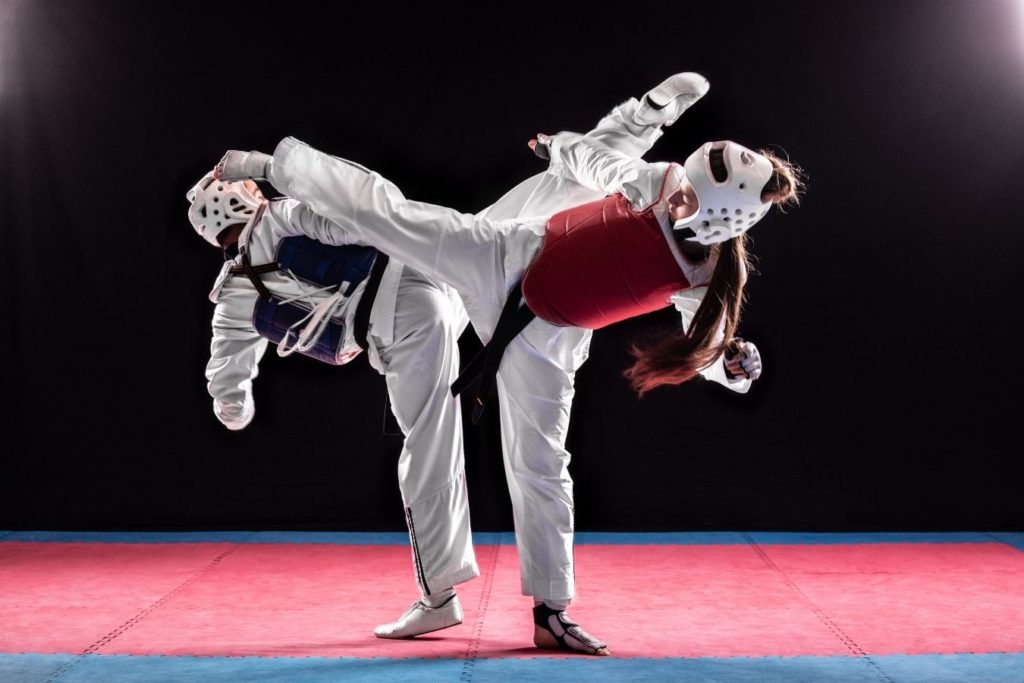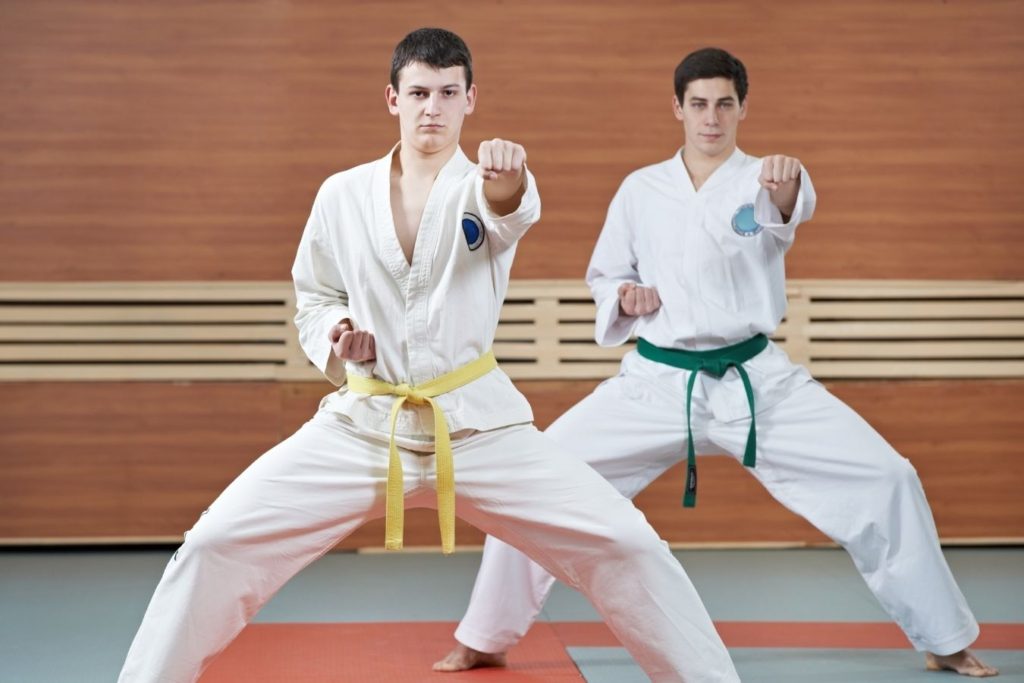Once you enroll in martial arts classes, you will come across two common options: Karate and Taekwondo. You may have learned about Karate from the infamous Mr. Myagi, whereas Taekwondo can typically fly under the radar.
Karate is a Japanese martial art, whereas Taekwondo originates from Korea. Both are traditional striking martial arts with a solid sports element, but Taekwondo places considerable emphasis on kicking, while Karate is more well-rounded.
Karate and Taekwondo can be useful in situations where you must defend yourself, which is why many people start training initially. They may not be perfect for real-life fighting, but all traditional martial arts have a lot of other values than pure fighting skills.
You might wonder about the difference between the two and which one is more suitable for you, and this publication will help you decide.
The History of Karate

The first practice of Karate can be traced to around 500 years ago on the island of Okinawa in Japan.
Discover The Little Known Secrets For Unlocking Devastating KO Power!
Heavy hands are built doing these things...
Although there isn’t much written evidence to back this up, many people believe that Karate was created when King Shoha, who ruled back then, stopped using weapons on their Island to prevent war. For this reason, people started to use hand-to-hand combat to defend themselves.
Karate has both Chinese and Japanese influence since the two cultures were exposed to one another.
The man who systemized and popularized Karate in the form we know it today was Gichin Funakoshi, who also created the Shotokan style of Karate.
His followers picked up where he left off and established the Japan Karate Association in 1949 to promote his martial arts style.
In the U.S., the first karate space for training opened in 1945 and has spread worldwide over the years. Shotokan is far from the only Karate, and there are dozens of different styles. The most popular ones include:
- Wado-Ryu
- Shotokan
- Shito-Ryu
- Goju-Ryu
- Kyokushin
Origins of Taekwondo

Taekwondo has ancient roots as well. The earliest records of people who practiced the predecessor hand-to-hand combat styles date back to 50 B.C.E in Korea.
Tae means to kick, whereas Kwon means to punch or destroy, and Do means a way of doing things. So, in short, Taekwondo means to use your entire body to defend yourself.
When Japan took over Korea in the 1900s, the Japanese banned military arts training, which included Taekwondo.
However, some groups went on to practice it in secret, whereas others traveled to learn arts in Japan and China. Since Judo, Kung Fu, and Karate were all introduced in Korea, Taekwondo morphed into different styles due to their influence.
The Taekwondo that we learn today started in 1955 when Kwan (martial arts schools in Korea) masters merged their styles to produce a uniform martial art, which they named Taekwondo.
The style became the national martial art of Korea and has since gained immense popularity, not least because it is an Olympic discipline.
What Are The Differences Between Karate and Taekwondo?
Taekwondo and Karate can be very similar to someone who recently developed an interest in martial arts. But when you look at their gear, techniques, and rules, you can understand how different they are.
Both art forms can be differentiated based on the following factors:
Techniques
Karate is more popularly known as the art of striking. It features kicking, punching, knees, elbows, and other open-hand techniques.
Some styles also incorporate joint manipulations, vital point striking, grappling, and throws to a different degree, but all Karate styles remain predominantly striking arts.
For Karate, the practitioner has to undergo hard physical training to develop skills that require mental and strenuous physical discipline.
Karate means “empty hands,” which refers to the fact that Karate is a system of self-defense that relies entirely on using an unarmed body.
Taekwondo is popular for using almost exclusively kicking techniques, which makes it different from Karate.
The Korean style has many different kicks, from simple front kicks to powerful side kicks and roundhouses to the most style-specific flying and spinning techniques.
Style/Forms

Taekwondo is taught in two different forms—Kata and sparring. Kata, similar to Karate, is known as “form,” a choreographed routine of martial arts movements.
On the other hand, Taekwondo sparring is full-contact fighting using a combination of offensive and defensive tricks and techniques against your opponent.
Karate training consists of three elements- Kata, Kihon, and Kumite. Kihon stands for basics and is the root of style. Kihon training includes drilling strikes, blocks, stances, and movements in the air.
Kata stands for form and is a sequence of movements to form a pattern you must memorize. Kata training involves elements such as speed, technique, direction, rhythm, and power.
The sparring in Karate is called kumite. The type and intensity of sparring depend on the style, but it is always an important part of practice.
Rules
Karate has two main distinct rulesets- light contact and full contact. Shotokan is the most popular style, and it is light contact, meaning the aim is to outscore the opponent by landing varied attacks and not hurting him.
Excessive force is penalized in these styles, so you cannot win by a knockout. Think of these styles as fencing with hands and feet.
A score is awarded when a practitioner performs a technique that conforms to the following criteria and lands on a legal target zone:
- Good form
- Accurate distance
- Vigorous application
- Good timing
- Awareness
- Sporting attitude
Fighters can score one, two, or three points for attacking techniques; three points are awarded for a head kick or any scoring technique performed on a fallen opponent.
Two points are given for mid-level kicks, and one point is awarded for mid or upper-level punches.
The other type of karate competition is called full contact or knockdown Karate, and the most popular representative is Kyokushin.
Full-contact striking is allowed in these styles, and a knockout is a viable way to win the competition. However, punching the head is not permitted.
On the other hand, scoring for a taekwondo match goes the following way. A player gets three points for a kick to the head, two points for a spinning kick to the opponent’s torso, and one point for a basic attack on their torso. Punches to the head are forbidden.
In major Taekwondo competitions, electronic scoring systems register valid attacks according to the pressure exerted on the system.
When electronic scoring is not used, panels of four judges have to push a button when they see scoring points, and when three judges agree to the score, a point is awarded.
Gear
A Taekwondo uniform is white and is known as the dobok. It has a long-sleeved cotton top, drawstring pants, and a colored belt, signifying the wearer’s rank.
Taekwondo uses a lot of protective equipment. This includes:
- Taekwondo style gloves
- Chest protector
- Headgear
- Forearm guards
- Groin guard
- Shin and footguards
The Karate uniform is called a gi and is very similar to that used in Taekwondo (actually, the dobok is derived from the gi as Karate is older).
The protective equipment depends on the style. Light contact styles use special karate gloves, headgear, and shin guards, while full contact styles only use small gloves and shin guards.
Belt System
The belt system is important in both Karate and Taekwondo. These systems present a clear hierarchy and tangible goals and are widely used in martial arts. This does not mean the belts are the same, though.
In fact, they are not even the same among different Karate or taekwondo organizations, so for the comparison, we will use the two most popular systems- World Taekwondo (Olympic) and Shotokan Karate.
The belt system is WT, which includes white, yellow, orange, green, blue, brown, and black belts. The colored belt ranks are called geup and start from the 10th geup as a white belt.
Once you reach the black belts, the ranks are called dans and begin at 1st dan and go upwards.
The karate system is almost the same, with the difference being that the colored ranks are called kyu, and the progressions go white, yellow, orange, green, purple, brown, and black.
Competitive Scene
Unlike many traditional martial arts, Karate and Taekwondo have a well-developed competitive scene. Taekwondo has participated in the Olympic games since 1992 as a demonstration and since 2000 as a full sport. As such, it is highly competitive and popular with a large talent pool.
Light contact Karate also reached the Olympics in 2021, albeit briefly, but overall, it is also a very competitive style. Full contact styles are highly competitive and regularly hold events at all levels.
Both Karate and Taekwondo have competitions at all levels. They start from small kid tournaments and reach up to the World Championships and the Olympic games.
Karate vs. Taekwondo For MMA
Karate and Taekwondo are not the most well-represented styles in mixed martial arts, but both have been adapted and used at the highest level, with Karate being slightly better in general.
In the early days of MMA, traditional styles looked useless. Still, people like Lyoto Machida and Stephen Thompson found a way to transfer their karate skills and perplex their opponents, who were used to more typical kickboxing attacks.
The fast style of kicking, blinding speed of covering distance, and different punch technique makes karate stylists difficult opponents.
Even high-profile fighters without a karate background, like Connor McGregor and Henry Cejudo, have borrowed Karate’s stance and kicking style for MMA.
Being entirely centered around kicks, Taekwondo is less useful in MMA, but it also teaches some incredible kicking techniques, balance, distance management, and footwork.
When fighters like Anthony Pettis and Yair Rodriguez fight and use their taekwondo background, they often create magic and some of the most spectacular highlights.
Is Karate or Taekwondo Better For Self-Defense?

Karate and Taekwondo belong to the same branch of martial arts, but Karate is the better one thanks to the more well-rounded striking techniques used.
Karate gives equal time on foot and hand techniques, whereas Taekwondo focuses entirely on kicks. Taekwondo kicks are extremely powerful but hardly applicable in many real situations where clothing and space are a factor.
Light contact karate teaches some bad habits, like pulling your punches, while Taekwondo is full contact, but the greater versatility of Karate makes it better for self-defense.
The entire emphasis of Taekwondo is success under its super-specialized ruleset, which makes competitions very entertaining but not at all realistic.
Full-contact Karate is often better in real life because it prepares you better for throwing and receiving strikes to deal damage.
Martial Arts vs. Karate & Taekwondo
This is often a mix-up in terminology. There are no martial arts vs. Taekwondo or Karate. Both Karate and Taekwondo are martial arts. Martial arts is simply a blanket term that encompasses many different styles of combat sports.
Should You Learn Karate or Taekwondo?
Both Karate and Taekwondo are great martial arts. Fundamentally, they are systems for complete character development and aim to improve physical, mental, and spiritual well-being.
Both are suitable for children, and I believe they are often better as a first martial art for kids than combat sports like boxing, wrestling, or Muay Thai, despite them being much better at actual fighting.
However, consider the factors presented in this article when choosing between the two.
Karate is more well-rounded, realistic, and better for self-defense. In addition, it has fewer physical requirements regarding agility and flexibility. On the other hand, Taekwondo is more attractive and entertaining, which some prefer.

